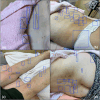Developing a deep learning model for the automated monitoring of acupuncture needle insertion: enhancing safety in traditional acupuncture practices
- PMID: 40102810
- PMCID: PMC11917098
- DOI: 10.1186/s12906-025-04853-7
Developing a deep learning model for the automated monitoring of acupuncture needle insertion: enhancing safety in traditional acupuncture practices
Abstract
Background: Acupuncture is a widely practiced traditional therapy, yet safety concerns, particularly needle breakage and retention, remain critical issues that can lead to complications such as infections, organ injury, or chronic pain. This study aimed to develop a deep learning model to monitor acupuncture needle insertion, detect instances of needle breakage, and prevent needle retention, ultimately improving patient safety and treatment outcomes.
Methods: A deep learning model based on the YOLOv8 architecture was trained using a dataset comprising 192 images from a commercial image library and 73 clinical images captured during real-world acupuncture sessions. Images were preprocessed through cropping and annotation, and augmented to enhance model generalizability. Five-fold cross-validation was employed to ensure robust performance. Model evaluation metrics included precision, recall, F1 score, and mean average precision (mAP) at Intersection over Union (IoU) thresholds of 50% (mAP@50) and 50-95% (mAP@50-95).
Results: The model demonstrated strong performance, achieving an average precision of 88.0% and a recall of 82.9%. The mean average precision was 88.6% at mAP@50 and 62.9% at mAP@50-95, indicating high reliability in detecting acupuncture needles across diverse scenarios. These results highlight the potential of the model to enhance clinical safety by minimizing risks associated with needle breakage and retention, regardless of practitioner experience or patient demographics.
Conclusions: The proposed YOLOv8-based deep learning model offers a reliable method for real-time needle monitoring in acupuncture. Its integration into clinical workflows can improve safety and efficiency, especially in underserved regions or settings with less experienced practitioners. Future research should validate the model with larger, more diverse datasets and explore its application in various healthcare settings.
Trial registration: Not applicable; this study did not involve a healthcare intervention requiring registration. Data collection adhered to ethical standards with institutional approval (TCHIRB-11310004).
Keywords: Acupuncture needle; Acupuncture practice; Deep learning; Needle detection; Safety.
© 2025. The Author(s).
Conflict of interest statement
Declarations. Ethics approval and consent to participate: All methods were performed in accordance with the relevant guidelines and regulations in the Declaration of Helsinki. Informed consent was obtained from all subjects. The research protocol was approved by the Taipei City Hospital Research Ethics Committee under approval number TCHIRB-11310004. Informed consent was obtained from all subjects. Consent for publication: Not Applicable as there were no identifiable details of individuals reported in the manuscript. Competing interests: The authors declare no competing interests.
Figures

References
-
- Fang X, Tian Z, Xie B, Guo H. Removal of an acupuncture needle accidentally broken in the neck. Asian J Surg. 2019;42(4):582–3. - PubMed
-
- Wong TH, Wei J, Chen H, Ng BFL. A novel deep learning based cloud service system for automated acupuncture needle counting: a strategy to improve acupuncture safety. Digit Chin Med. 2024;7(1):40–6.
MeSH terms
Grants and funding
LinkOut - more resources
Full Text Sources
Medical

